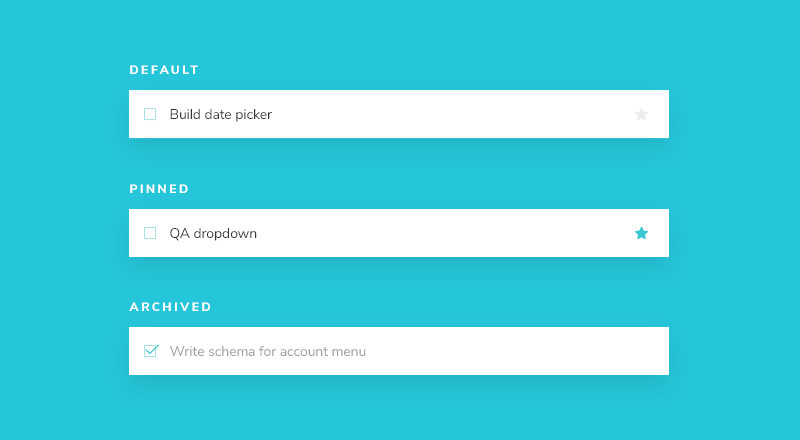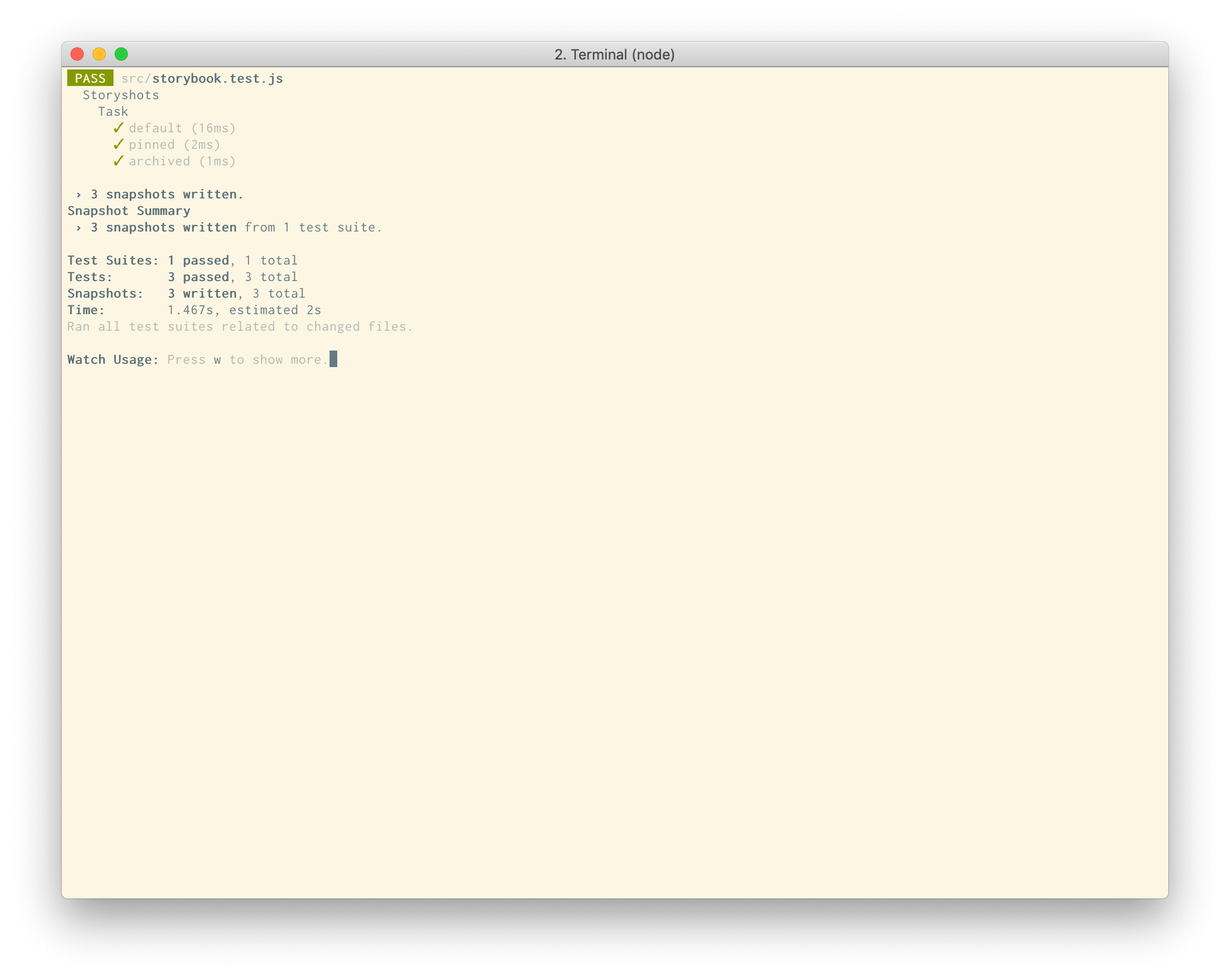Angular How To Create A Component
We'll build our UI following a Component-Driven Development (CDD) methodology. It's a process that builds UIs from the "bottom-up", starting with components and ending with screens. CDD helps you scale the amount of complexity you're faced with as you build out the UI.
Task

Task is the core component of our app. Each task displays slightly differently depending on exactly what state it's in. We display a checked (or unchecked) checkbox, some information about the task, and a "pin" button, allowing us to move tasks up and down the list. Putting this together, we'll need these props:
-
title– a string describing the task -
state- which list is the task currently in, and is it checked off?
As we start to build Task, we first write our test states that correspond to the different types of tasks sketched above. Then we use Storybook to create the component in isolation using mocked data. We'll manually test the component's appearance given each state as we go.
Get setup
First, let's create the task component and its accompanying story file: src/app/components/task.component.ts and src/app/components/task.stories.ts.
We'll begin with the baseline implementation of the Task component, simply taking in the inputs we know we'll need and the two actions you can take on a task (to move it between lists):
src/app/components/task.component.ts
import { Component, Input, Output, EventEmitter } from '@angular/core'; @Component({ selector: 'app-task', template: ` <div class="list-item"> <input type="text" [value]="task.title" readonly="true" /> </div> `, }) export class TaskComponent { @Input() task: any; // tslint:disable-next-line: no-output-on-prefix @Output() onPinTask = new EventEmitter<Event>(); // tslint:disable-next-line: no-output-on-prefix @Output() onArchiveTask = new EventEmitter<Event>(); } Above, we render straightforward markup for the Task component based on the existing HTML structure of the Todos app.
Below we build out Task's three test states in the story file:
src/app/components/task.stories.ts
import { moduleMetadata, Meta, Story } from '@storybook/angular'; import { CommonModule } from '@angular/common'; import { action } from '@storybook/addon-actions'; import { TaskComponent } from './task.component'; export default { component: TaskComponent, decorators: [ moduleMetadata({ declarations: [TaskComponent], imports: [CommonModule], }), ], title: 'Task', excludeStories: /.*Data$/, } as Meta; export const actionsData = { onPinTask: action('onPinTask'), onArchiveTask: action('onArchiveTask'), }; const Template: Story = args => ({ props: { ...args, onPinTask: actionsData.onPinTask, onArchiveTask: actionsData.onArchiveTask, }, }); export const Default = Template.bind({}); Default.args = { task: { id: '1', title: 'Test Task', state: 'TASK_INBOX', updatedAt: new Date(2021, 0, 1, 9, 0), }, }; export const Pinned = Template.bind({}); Pinned.args = { task: { ...Default.args.task, state: 'TASK_PINNED', }, }; export const Archived = Template.bind({}); Archived.args = { task: { ...Default.args.task, state: 'TASK_ARCHIVED', }, }; There are two basic levels of organization in Storybook: the component and its child stories. Think of each story as a permutation of a component. You can have as many stories per component as you need.
-
Component
- Story
- Story
- Story
To tell Storybook about the component we are documenting, we create a default export that contains:
-
component--the component itself -
title--how to refer to the component in the sidebar of the Storybook app -
excludeStories--exports in the story file that should not be rendered as stories by Storybook.
To define our stories, we export a function for each of our test states to generate a story. The story is a function that returns a rendered element (i.e., a component class with a set of props) in a given state---exactly like a Functional Component.
As we have multiple permutations of our component, assigning it to a Template variable is convenient. Introducing this pattern in your stories will reduce the amount of code you need to write and maintain.
💡 Template.bind({}) is a standard JavaScript technique for making a copy of a function. We use this technique to allow each exported story to set its own properties, but use the same implementation.
Arguments, or args for short, allow us to live-edit our components with the controls addon without restarting Storybook. Once an args value changes, so does the component.
When creating a story, we use a base task arg to build out the shape of the task the component expects, typically modeled from what the actual data looks like.
action() allows us to create a callback that appears in the actions panel of the Storybook UI when clicked. So when we build a pin button, we'll be able to determine if a button click is successful in the UI.
As we need to pass the same set of actions to all permutations of our component, it is convenient to bundle them up into a single actionsData variable and pass them into our story definition each time.
Another nice thing about bundling the actionsData that a component needs is that you can export them and use them in stories for components that reuse this component, as we'll see later.
💡 Actions help you verify interactions when building UI components in isolation. Oftentimes you won't have access to the functions and state you have in context of the app. Use action() to stub them in.
Config
We'll also need to make one small change to the Storybook configuration to notice our recently created stories. Change your configuration file (.storybook/main.js) to the following:
.storybook/main.js
module.exports = { - stories: [ - '../src/**/*.stories.mdx', - '../src/**/*.stories.@(js|jsx|ts|tsx)' - ], + stories: ['../src/app/components/**/*.stories.ts'], addons: [ '@storybook/addon-links', '@storybook/addon-essentials', '@storybook/addon-interactions', ], }; Once we've done this, restarting the Storybook server should yield test cases for the three states of TaskComponent:
Specify data requirements
It's best practice to specify the shape of data that a component expects. Not only is it self documenting, but it also helps catch problems early. Here, we'll use Typescript and create an interface for the Task model.
Create a new directory called models inside the app directory, followed by a new file called task.model.ts:
src/app/models/task.model.ts
export interface Task { id: string; title: string; state: string; } Build out the states
Now that we have Storybook setup, styles imported, and test cases built out, we can quickly start implementing the HTML of the component to match the design.
The component is still rudimentary at the moment. First, write the code that achieves the design without going into too much detail:
src/app/components/task.component.ts
import { Component, Input, Output, EventEmitter } from '@angular/core'; + import { Task } from '../models/task.model'; @Component({ selector: 'app-task', template: ` + <div class="list-item {{ task?.state }}"> + <label class="checkbox"> + <input + type="checkbox" + [defaultChecked]="task?.state === 'TASK_ARCHIVED'" + disabled="true" + name="checked" + /> + <span class="checkbox-custom" (click)="onArchive(task.id)" attr.aria-label="archiveTask-{{ task?.id }}"></span> + </label> + <div class="title"> + <input + type="text" + [value]="task?.title" + readonly="true" + placeholder="Input title" + /> + </div> + <div class="actions"> + <a *ngIf="task?.state !== 'TASK_ARCHIVED'" (click)="onPin(task.id)"> + <span class="icon-star" attr.aria-label="pinTask-{{ task?.id }}"></span> + </a> + </div> + </div> `, }) export class TaskComponent { + @Input() task: Task; // tslint:disable-next-line: no-output-on-prefix @Output() onPinTask = new EventEmitter<Event>(); // tslint:disable-next-line: no-output-on-prefix @Output() onArchiveTask = new EventEmitter<Event>(); + /** + * Component method to trigger the onPin event + * @param id string + */ + onPin(id: any) { + this.onPinTask.emit(id); + } + /** + * Component method to trigger the onArchive event + * @param id string + */ + onArchive(id: any) { + this.onArchiveTask.emit(id); + } } The additional markup from above, combined with our existing CSS (see src/styles.css and angular.json for configuration), yields the following UI:
Component built!
We've now successfully built out a component without needing a server or running the entire frontend application. The next step is to build out the remaining Taskbox components one by one in a similar fashion.
As you can see, getting started building components in isolation is easy and fast. We can expect to produce a higher-quality UI with fewer bugs and more polish because it's possible to dig in and test every possible state.
Automated Testing
Storybook gave us a great way to manually test our application UI during construction. The stories will help ensure we don't break our Task's appearance as we continue to develop the app. However, it is an entirely manual process at this stage, and someone has to go to the effort of clicking through each test state and ensuring it renders well and without errors or warnings. Can't we do that automatically?
Snapshot testing
Snapshot testing refers to the practice of recording the "known good" output of a component for a given input and then flagging the component whenever the output changes in the future. It complements Storybook because it's a quick way to view the new version and check out the differences.
💡 Make sure your components render data that doesn't change so that your snapshot tests won't fail each time. Watch out for things like dates or randomly generated values.
A snapshot test is created with the Storyshots addon for each of the stories. Use it by adding the following development dependencies:
npm install -D @storybook/addon-storyshots Then create the src/storybook.test.js file with the following in it:
src/storybook.test.js
import initStoryshots from '@storybook/addon-storyshots'; initStoryshots(); Finally, we need to make a small change in the jest key in our package.json:
package.json
{ "transform": { "^.+\\.(ts|html)$": "ts-jest", "^.+\\.js$": "babel-jest", + "^.+\\.stories\\.[jt]sx?$": "@storybook/addon-storyshots/injectFileName" }, } That's it. We can run npm run test and see the following output:

We now have a snapshot test for each of our Task stories. If we change the implementation of Task, we'll be prompted to verify the changes.
💡 Don't forget to commit your changes with git!
Angular How To Create A Component
Source: https://storybook.js.org/tutorials/intro-to-storybook/angular/en/simple-component/
Posted by: johnsonbefteeprishe.blogspot.com

0 Response to "Angular How To Create A Component"
Post a Comment